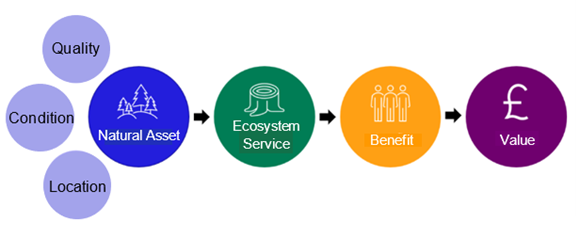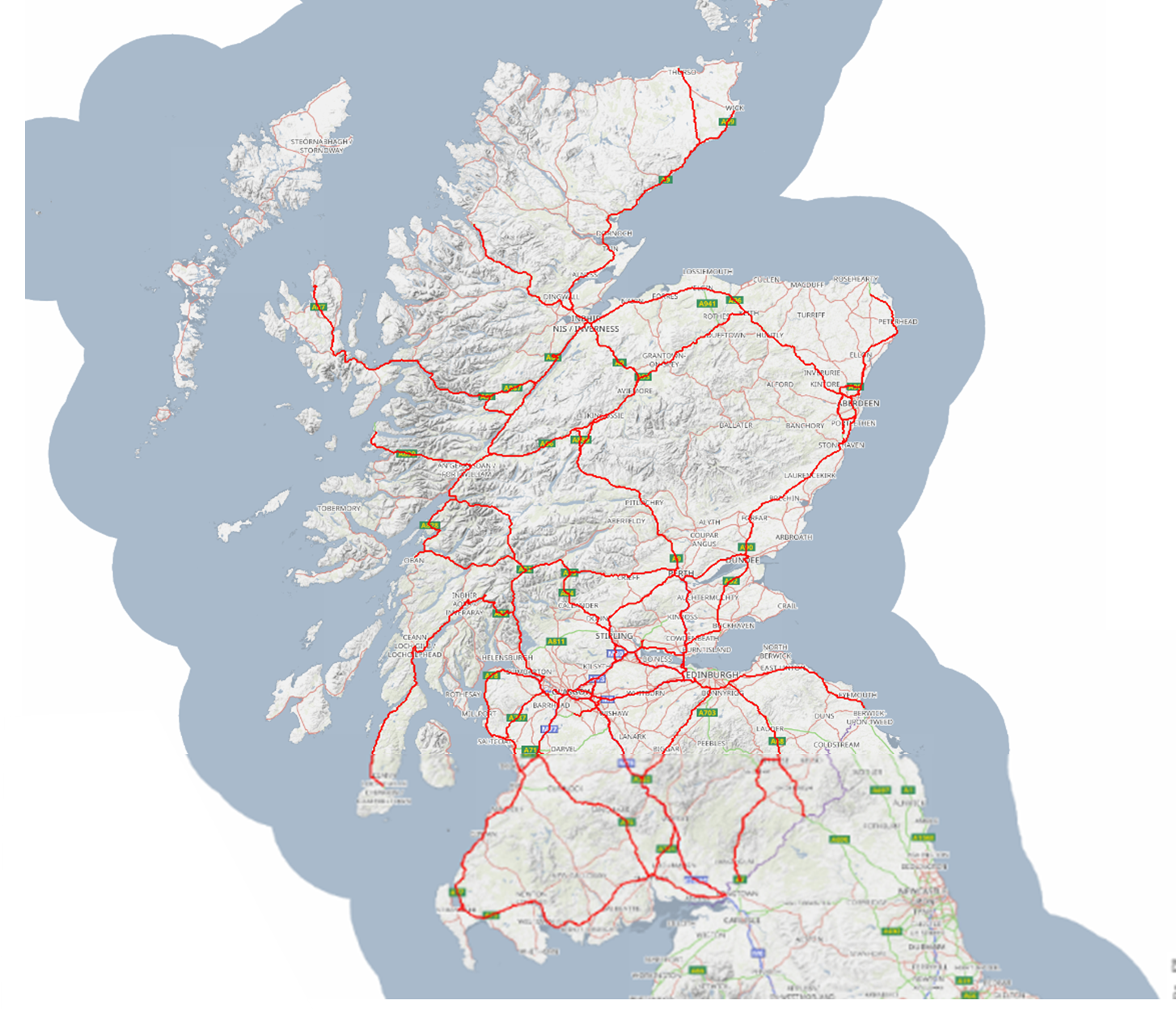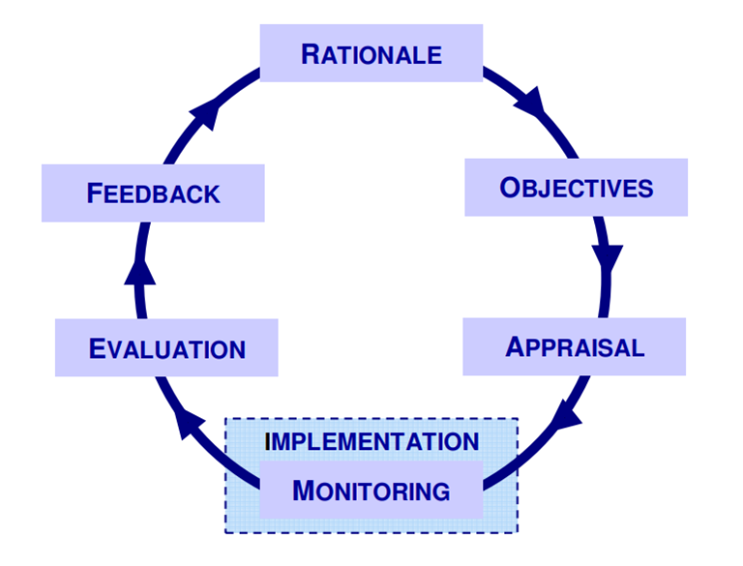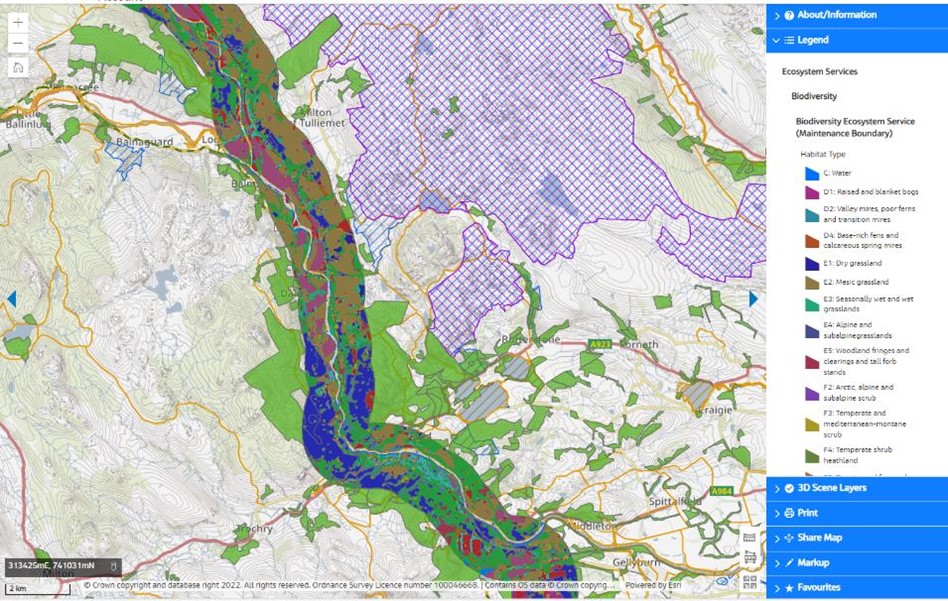Mainstreaming and Governance
Transport Scotland Landscape Policy
For over two decades the Agency has promoted an approach to landscape design and the management of the land within its remit that encourages designers and managers to take inspiration from the natural processes that shape the wider environment. This is further articulated within the current landscape policy, Fitting Landscapes: Securing more sustainable landscapes. The policy is mandatory for all involved in works affecting the trunk road estate and renews and reinforces the Agency’s commitment to appropriate environmental custodianship.
It is notable that Scotland Environmental Strategy, published in 2020, reflects similar objectives to those promoted by the Agency’s current and previous landscape policy – the protection of nature; mitigation against climate change; and the wise use of resources.
Proposed TS Biodiversity Strategy
Scottish Ministers have stated that the challenges facing biodiversity loss are as important as the challenge of combatting climate change. Influential publications, including the State of Nature Report (2023) and the earlier State of Nature Scotland Report (2019), clearly identify the extent of the emergency we face and the importance of investing in nature.
For example, support for projects to increase tree planting and improve grasslands makes a significant contribution to reducing the impacts of climate change by sequestering carbon to reinforce our NetZero commitments, whilst at the same time achieving critical biodiversity improvements.
As the agency responsible for one of the Scottish Government’s most valuable assets and a significant landholding, Transport Scotland must ensure its own policies and programmes align with these challenging targets, and a sectoral biodiversity strategy is considered key to understanding and delivering the changes this requires.
The government has announced ambitious targets for nation to be nature-positive by 2030, and to have restored and regenerated biodiversity across the country by 2045. This is detailed in the recently published Scottish Biodiversity Strategy 2022-45 which identifies that biodiversity conservation calls for an ecosystem approach - seeking the integrated management of land, water and living resources that promotes conservation and sustainability in an equitable way. As shown in Figure 21, the intention is to reverse the downward curve of biodiversity loss before 2030 so that levels of biodiversity are once again increasing.
At the same time, the strategy promotes a framework of action aimed at delivering to a ‘nature positive’ nation, where biodiversity is systematically mainstreamed across sectors and the wider policy landscape.
It is important that Transport Scotland, like other public bodies, is prepared to introduce the required changes to our processes and practices to ensure the agency does all it can to support the national outcomes and targets we need to deliver. The quality and interconnectivity of ecosystems associated with the agency’s assets require urgent attention to ensure they are in the best condition to mitigate and adapt to climate change and for delivering positive outcomes for biodiversity.
Due to the challenging fiscal environment, delivery of the proposed Transport Scotland biodiversity strategy has been delayed, pending budget approval. The procurement process is underway, and it is planned to deliver the strategy next financial year.
In the meantime, work is continuing to prepare and deliver a Natural Capital baseline assessment (and set of accounts) of the Scottish Trunk Road Network. This work will directly link to and inform the planned biodiversity, whilst helping to mainstream consideration for all aspects of the environment in all the Agency’s operations.
Trunk Road Network Natural Capital Assessment
There is currently no mandate or obligation in Scotland for organisations to prepare natural capital accounts. However, there is clear recognition of the importance of understanding and measuring natural capital if Scotland is to enhance its accountability and ability to achieve policy goals and become Nature Positive by 2030 and to restore and regenerate biodiversity by 2045.
These are the primary targets in the Scottish Biodiversity Strategy to 2045 which will focus on the identified needs of strategic working that mainstreams biodiversity across all sectors, supported by appropriate levels of funding. In addition, the Strategy requires evidence-based monitoring to ensure targets are achieved. Natural capital accounting is seen as vital part of this framework and will be embedded into future policy making.
Transport Scotland recognises the need to incorporate natural capital into our decision making; not only at the individual scheme/investment level but also in our operational strategy and decision making going forward. The protection and enhancement of the natural environment is an important aspect of all transport projects, to which the Agency is fully committed. To facilitate this thinking, a cohesive, coordinated approach is required that can be scaled appropriately to support our various operations, maintenance regimes and capital programmes across the Trunk Road Network.
Some transport projects have already begun to incorporate natural capital; however, it was determined that a full baseline and account of the entire Trunk Road Network will provide a useful resource to shape future projects and programmes, inform decision making, and measure progress.
Natural Capital is defined by the Scottish Natural Capital Accounts (SNCA) as:
“the world's stock of natural resources. This includes air, water, minerals, and all living things. These natural resources underpin our society and economy because they provide a wide range of benefits”
One of the benefits of taking a baseline approach is to help focus on the "big things" that would make a difference. This may include action on peatland surveys and restoration programmes and to understand the scale of woodland creation that might be required. Applying Natural Capital approaches ensures that the benefits nature brings are not overlooked and can be protected and enhanced (see Figure 23). It is also a means by which changes relative to the baseline over time can be measured to assess progress. This is discussed further in the Monitoring Section.

Following a research and development process by experienced consultants, a methodology was devised that was appropriate to assessing and evaluating the natural capital of the trunk road network. The methodology utilised a logic process incorporating the following steps, as illustrated in Figure 23, above:
- natural asset, (assessed by quality, condition and location), leading to;
- ecosystem service, leading to;
- benefit, leading to an assessment of;
- value.
The Scottish Trunk Road Network represents a significant sized linear landholding, as shown in the map below, and this presents a particular challenge for a natural capital baseline assessment methodology. This methodology was tested in Phase 1 of the initiative, which saw the development of a spatial tool hosted on a geospatial platform. This provides a dynamic, interactive interface where the user can zoom in or out on a geography and understand the biophysical and (in some instances) monetised values for different ecosystem services.

Numerous ecosystem services have been quantified and, in some cases, valued. These include food production, wood production, carbon sequestration and storage, flood regulation, water quality recreation, noise reduction, pollination and biodiversity. The majority of the approaches utilised to quantify and value these ecosystem services are aligned to those recommended by Defra’s Enabling a Natural Capital Approach.
At this stage, the work has been applied at two scales: The first is an assessment of selected ecosystem services within the maintenance boundary of the trunk road network - the land managed by Transport Scotland, or over which the Agency has a legal responsibility (referred to as Scope 1). The second scale is a 1km buffer area either side of the road, representing land that our operations may have influence over, and vice versa (referred to as Scope 2).
This approach is aligned with the BSI BS 8623:2021 Natural Capital Accounting for Organisations standard, and ensures the developing tool facilitates appropriate consideration of adjacent land interests, promoting greater opportunities for enhancing habitat connectivity and for partnership working with other public and private sector landowners.
Monitoring
Monitoring of progress and performance is a key part of effective business management, and this is true for Transport Scotland and its operational delivery. However monitoring is not an isolated element or a means to an end – it is part of an iterative process aimed at ensuring the objectives of each intervention are met and, where appropriate, lessons are learned to enhance the design and delivery of future workstreams. This is only possible where there is clear understanding of the intended objectives, whether these are at the strategic level or more project-specific.

Figure 25, illustrates the interconnected cycle for monitoring from Rationale to Objectives, Appraisal, Monitoring, Evaluation and finally Feedback, which informs the Rationale. Monitoring therefore relies on a well-defined and robust assessment and analysis of what the intervention is planned to achieve, together with its impacts on the wider environment.
For Transport Scotland, this process is underpinned by the Scottish Government’s vision for transport set out in the NTS2 and the associated Delivery Plans. The Plans are reviewed and assessed by applying the STAG.
STAG requires evaluation against indicators and targets derived for the Transport Planning Objectives originally set for a scheme or project. STAG criteria cover Environment, Climate Change, Health, Safety and Wellbeing, Economy, Equality and Accessibility, with biodiversity and habitats included in the Environment section.
The Guidance notes that transport infrastructure has a number of potential effects on biodiversity and habitats, including;
- Direct damage to nature conservation sites or the habitats of protected species;
- Fragmentation or loss of habitats;
- Barriers to the movement and genetic interchange between populations;
- Disturbance of habitats and species due to factors such as noise, light pollution and contaminated run-off.
The overall objective of the appraisal is that schemes should aim to maintain the level of biodiversity in the study area, including wildlife habitats and species, and to improve the status of rare and vulnerable species wherever possible. This reflects one of the key milestones of the National Biodiversity Strategy, to halt biodiversity loss by 2030.
The Strategic Delivery Framework in support of the National Biodiversity Strategy commits us all to seek to demonstrate performance against clear objectives and this provides the momentum to reinforce our processes and procedures to align with the overarching national vision and outcomes.
Natural Capital Monitoring
According to the Natural Capital Committee, a Natural Capital baseline can be defined as:
‘the starting measurement point of Natural Capital assets - changes relative to the baseline over time provide a measure of progress or decline.’
The work Transport Scotland is currently engaged in to prepare a natural capital baseline assessment of the Trunk Road Network will provide the Agency with a robust means to record and value change over time.
It will facilitate the assessment of progress in support of the biodiversity targets, as well as the protection and enhancement of a range of ecosystem services provided by the estate, including the impacts and inter-dependencies across the whole value chain.

For Transport Scotland this work is still in progress, but it presents a real opportunity for Agency to make better, more informed decisions on where and how to deliver changes to the estate that are inherently sustainable and in support of the critical resources on which society depends.
Post-scheme Evaluation
The evaluation of trunk road projects after construction is set out in Scottish Trunk Road Infrastructure Project Evaluation (STRIPE), with two separate, programmed evaluations carried out on relevant projects, as follows:
- A one-year after Evaluation (1YA) – prepared one year after opening, this report should provide early indication that the project is operating as planned and is on-track to achieve its objectives. This includes a detailed assessment of the environmental objectives of the scheme, including delivery against any biodiversity targets. As this evaluation is within the establishment period of the works there is ample opportunity to redress any noted failings.
- A Detailed Evaluation – undertaken between three and five years after opening. This second evaluation considers a project’s impacts, whether it has achieved its objectives and reviews the actual impacts against forecasts and determines the causes of any variances. This is important as a ‘lessons learnt’ approach for the preparation, delivery and maintenance of future schemes.
Scheme Maintenance
All new interventions have an associated maintenance period as part of the contract requirements.
For Transport Scotland trunk road schemes this is usually between 3 – 5 years. The contractor is required to manage and maintain the scheme in accordance with the obligations set out in the contract and there are periodic inspections to monitor progress towards delivery before the scheme is fully complete and subsumed as part of the trunk road network.
Network management
The existing trunk road network is managed and maintained by Operating Companies working to term commissions of between 5 – 7 years duration. The actions of these companies is monitored, assessed and audited by an independent company - Performance Audit Group (PAG).
PAG employ specialists to ensure the contractors deliver all their contract obligations and that all interventions are undertaken in accordance with the contract requirements and related legislation/policy.
This includes all environmental matters, from grass cutting to discrete design projects. This assessment and monitoring is supported by Transport Scotland in-house staff.